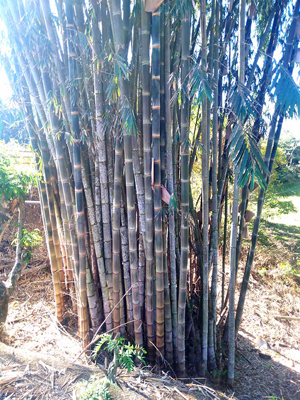WHO would ever have thought that the iconic, taken-for-granted and once-ubiquitous bamboo could rise beyond the thatched nipa huts of the countryside, common benches and side chairs peddled in many Philippine cities and towns, and simple support poles in small construction projects and banana plantations?
At a common government service facility in coastal Naawan town of Misamis Oriental, new furniture designs are coming out of this community endeavor and have given a pleasant surprise to even the Mindanao Development Authority (MinDA), which sees the common bamboo of the grass family as the likely main material for a sustainable and environment-friendly greening of many watersheds of Mindanao.

“The common service facility now produces high-end furniture and school desks made out of bamboo, mostly the Giant Bamboo variety,” said Secretary Emmanuel Piñol, chief of the MinDA.
The former chief of the Department of Agriculture (DA) visited the facility along with Mayor Dennis Roa early this month, and reported seeing high-quality bamboo products which were manually made in the common service facility by the local people themselves.
He said Mayor Roa is now actually on the search for a talented furniture designer who could help the local bamboo furniture makers build attractive and commercially viable products.
Not just for greening
MinDA has its own long-term plan to resuscitate many watershed areas of Mindanao to address constant flooding of the lowlands and minimize other environmental destruction, such as landslides and droughts.
The plan of MinDA’s Green Mindanao Project is also to reduce poverty among the Indigenous People’s (IP) communities “whose ancestral domains are minimally utilized for agricultural production.”
Upon seeing the products churned out at the service facility in the town of Naawan, Piñol said improved processing of bamboo would do more than providing simple livelihood to planters. Bamboo may also offer economic opportunities to communities around these processing centers.
Naawan, a fourth-class municipality in Northern Mindanao, is already reaping big gains from its small bamboo processing facility to improve the lives of its upland farmers, Piñol added.
The facility is located in the town’s Economic Enterprise Center established two years ago with financial support from the Department of Trade and Industry and MinDA. For now, the center still needs additional tools and equipment for furniture making.
Industry council
Also in Bukidnon, a private company established recently a bamboo processing facility in the capital of Malaybalay City.
Piñol said the Bukidnon Giant Bamboo Resources Corp. (BGB) established post-harvest facilities for bamboo “to treat, dry and process into slats, while doing integrated production from plantation to manufacturing of finished engineered bamboo products, such as lumber/beams and boards, building materials (doors, jambs, mouldings, etc.) and furniture using the most modern technology in the wood-working industry.”
Roderico R. Bioco, the BGB chairman, briefed him about the bamboo processing facility, after which he and Bioco “agreed to work on organizing the Mindanao Bamboo Industry Development Council to fully utilize the facilities and in the process boost the development of bamboo farming in Mindanao.”
Bioco had told him that starting with its bamboo innovation center in Aglayan, BGB expanded postharvest and manufacturing facilities in the Bukidnon towns of Impasugong, Talakag, Cabanglasan and Manolo Fortich and Claveria in Misamis Oriental.
“Core to the advocacy of BGB is engaging individual farmers and IP communities to expand bamboo propagation as an alternative source of income while able to address environmental concerns, especially the REDD+ program of our government to meet GHG emission reduction commitment under the Paris Agreement. BGB is also pursuing its own bamboo plantation,” Bioco said in a text message sent to Piñol.
“Our aim is to create a solid corporate platform of Environment, Social and Governance (ESG) to address at least seven of the 17 SDGs, reforest 100,000 hectares, mitigate the impact of global warming, improve water security and uplift the living standard of 100,000 families,” Bioco added.
Piñol said the council would form part of MinDA’s Industry Development Philosophy, “which aims to develop agriculture and fisheries by organizing and uniting the stakeholders who will be assisted through financing and market access by MinDA and its partners.”
He said the council would promote the greening of Mindanao’s critical watersheds and headwaters and, at the same time, provide income opportunities for the people. The original plan has included planting of bamboo as well as fruit trees and harvestable trees, “including the very valuable Agar Tree, in the denuded highlands of Mindanao,” Piñol said.
Meanwhile, last year, the DA in the Caraga Region said it has conducted a ceremonial bamboo planting to commemorate World Bamboo Day in September while continuing to pursue the DA’s program to promote its planting and propagation.
Regional Director Abel James I. Monteagudo was accompanied by his technical director, Nicandro M. Navia Jr., and acting technical director Rebecca R. Atega to the ceremonial planting at the Del Monte Lowland Rainfed Research Station (DMLRRS).
Value-added crop
IN February last year, Agriculture Secretary William D. Dar declared bamboo as a high-value crop to intensify its promotion.
In a news statement, Dar said the DA’s new agri-industrial strategy “does not only look at enhancing farm productivity, but also [at] developing more value-added products to further empower farmers by providing them with more business and employment opportunities, and eventually additional income.”
The DA said that aside from food products, bamboo is also used for construction, furniture, handicraft industry, fuel, textiles and the arts.
“Ecologically, compared to other trees, bamboo absorbs two times more carbon dioxide, which is essential for the survival, growth and reproduction of living things. Bamboo plants also have strong roots, which make it quite useful in preventing soil erosion,” the department said.
In Caraga, the DMLRRS is targeting to produce 1,000 pieces of bamboo planting materials to interested farmers.
